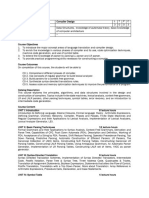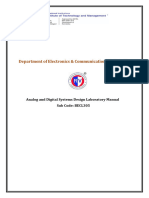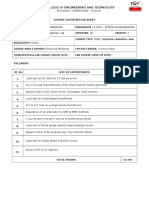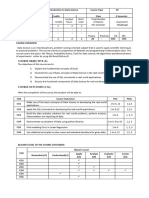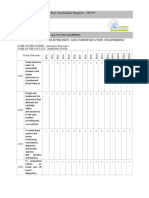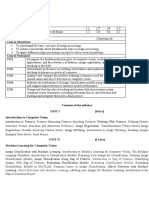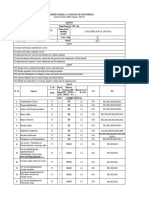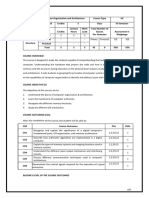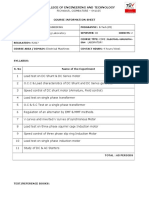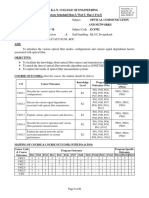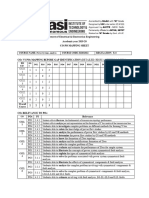D.E Course Plan
D.E Course Plan
Uploaded by
MU AsadCopyright:
Available Formats
D.E Course Plan
D.E Course Plan
Uploaded by
MU AsadOriginal Description:
Copyright
Available Formats
Share this document
Did you find this document useful?
Is this content inappropriate?
Copyright:
Available Formats
D.E Course Plan
D.E Course Plan
Uploaded by
MU AsadCopyright:
Available Formats
Digital Electronics L T P C
Version 1.0 3 0 0 3
Pre-requisites/Exposure -
Co-requisites Computer System Architecture
Course Objectives
1. Demonstrate a basic understanding of digital terminology, digital components, and
systems.
2. To prepare students to perform the analysis and design of various digital electronic
circuits.
3. To give the students a perspective to design combinational and sequential circuits.
Course Outcomes
On completion of this course, the students will be able to
CO1: Understand working of logic families and logic gates.
CO2: Design and implement Combinational and Sequential logic circuits.
CO3: Understand the process of Analog to Digital conversion and Digital to Analog
conversion.
CO4: Understand the configuration and working of Microprocessor.
Catalog Description
Explores the theory and operation of the basic building blocks of digital electronics with
emphasis on transistor logic (TTL) and complementary metal oxide semiconductor
(CMOS) integrated circuit logic families; prepares for continued study of theory and
operation of microprocessors and microcomputers.
Course Content
Unit 1: Fundamentals of Digital Systems and logic families 8 Hours
Digital signals, digital circuits, AND, OR, NOT, NAND, NOR and Exclusive-OR
operations, Boolean algebra, examples of IC gates, number systems-binary, signed
binary, octal hexadecimal number, binary arithmetic, one’s and two’s complements
arithmetic, codes, error detecting and correcting codes, characteristics of digital lCs,
digital logic families, TTL, Schottky TTL and CMOS logic, interfacing CMOS and
TTL, Tri-state logic.
Unit 2: Combinational Digital Circuits 10 Hours
Standard representation for logic functions, K-map representation, and simplification of
logic functions using K-map, minimization of logical functions. Don’t care conditions,
Multiplexer, De-Multiplexer/Decoders, Adders, Subtractors, BCD arithmetic, carry
look ahead adder, serial adder, ALU, elementary ALU design, popular MSI chips, digital
comparator, parity checker/generator, code converters, priority encoders,
decoders/drivers for display devices, Q-M method of function realization.
Unit 3: Sequential circuits and systems 10 Hours
A 1-bit memory, the circuit properties of Bistable latch, the clocked SR flip flop, J- K-T
And D-Types flip flops, applications of flip flops, shift registers, applications of shift
registers, serial to parallel converter, parallel to serial converter, ring counter,
sequence generator, ripple (Asynchronous) counters, synchronous counters, counters
design using flip flops, special counter IC’s, asynchronous sequential counters,
applications of counters.
Unit 4: A/D and D/A Converters 10 Hours
Digital to analog converters: weighted resistor/converter, R-2R Ladder D/A converter,
specifications for D/A converters, examples of D/A converter lCs, sample and hold circuit,
analog to digital converters: quantization and encoding, parallel comparator A/D
converter, successive approximation A/D converter, counting A/D
converter, dual slope A/D converter, A/D converter using voltage to frequency and
voltage to time conversion, specifications of A/D converters, example of A/D converter
ICs.
Unit 5: Introduction to Microprocessor. 7
Hours
Introduction to Microprocessors, Architecture of 8085 and 8086, Pin Configuration and
Function; Internal Register & Flag Register, Generation of Control Signals Bus Timings:
Demultiplexing of Address /Data Bus; Fetch Cycle, Execute Cycle, Instruction Cycle,
Instruction Timings and Operation Status, Timing Diagram. Instruction for Data Transfer.
Arithmetic and Logical Operations. Branching Operation: Machine Cycle Concept;
Addressing Modes.
Suggested Books:
TEXT/REFERENCES:
1. R. P. Jain, "Modern Digital Electronics", McGraw Hill Education, 2009.
2. M. M. Mano, "Digital logic and Computer design", Pearson Education India, 2016.
3. A. Kumar, "Fundamentals of Digital Circuits", Prentice Hall India, 2016.
Modes of Evaluation: Quiz/Assignment/ presentation/ extempore/ Written Examination
Examination Scheme:
Components Internal Mid Term ESE
Weightage (%) 50% 20% 30%
Relationship between the Course Outcomes (COs), Program Outcomes (POs) and
Program Specific Objectives (PSOs)
Program
Outcomes
PSO1
PSO2
PSO3
PO10
PO11
PO12
PO1
PO2
PO3
PO4
PO5
PO6
PO7
PO8
PO9
Course
Outcomes
CO 1 2 2 1
CO 2 2 2 1
CO 3 2 2 1
CO 4 2 2 1
Average 2 2 1
1=weak 2= moderate 3=strong
You might also like
- D&D Duet (5-6) - in The Heart of The Forest PDFDocument21 pagesD&D Duet (5-6) - in The Heart of The Forest PDFMorgan FogliazzaNo ratings yet
- De CurriculumDocument3 pagesDe Curriculumkharbsahab2005No ratings yet
- Digital System Design: After Successful Completion of This Course The Student Will Be Able ToDocument2 pagesDigital System Design: After Successful Completion of This Course The Student Will Be Able ToAMRIT SAHNo ratings yet
- Syllabus - Compiler DesignDocument2 pagesSyllabus - Compiler Design47 SARANG XII BNo ratings yet
- Updated - Analog & Digital Circuit Manual - BECL305Document98 pagesUpdated - Analog & Digital Circuit Manual - BECL305rvit22bec032.rvitmNo ratings yet
- JCT College of Engineering and Technology: Course Information SheetDocument6 pagesJCT College of Engineering and Technology: Course Information SheetDhamu DharanNo ratings yet
- 2csbs3104 Computational StatisticsDocument2 pages2csbs3104 Computational Statisticsgayatrisolanki774No ratings yet
- 21eec201j - Analog Electronics Lab Manual-2Document101 pages21eec201j - Analog Electronics Lab Manual-2ffsubukpmNo ratings yet
- Btech Ece SyllabusDocument14 pagesBtech Ece SyllabusSailokesh NagaruruNo ratings yet
- DLD1Document3 pagesDLD1Mr. RAVI KUMAR INo ratings yet
- R23 Yca2002Document4 pagesR23 Yca2002munnisujliNo ratings yet
- Microcontroller & IOT Lab Manual - Feb 2024Document36 pagesMicrocontroller & IOT Lab Manual - Feb 2024tausifansari2907No ratings yet
- Digital SyllabusDocument2 pagesDigital SyllabusPrakruthi K PNo ratings yet
- STLDDocument2 pagesSTLDPrasanth VarasalaNo ratings yet
- VL5301 Analog To Digital InterfacesDocument1 pageVL5301 Analog To Digital InterfacesRam MurthyNo ratings yet
- Digital ElectronicsDocument125 pagesDigital ElectronicsAditya SharmaNo ratings yet
- DE DLD SyllabusDocument4 pagesDE DLD SyllabusMr. RAVI KUMAR INo ratings yet
- IDS SyllabusDocument3 pagesIDS SyllabusKhaushik KumaarNo ratings yet
- B.Tech WT DS Elective 1Document2 pagesB.Tech WT DS Elective 1majidalam222No ratings yet
- Wa0017Document2 pagesWa0017Rohit VetrivelNo ratings yet
- EC8095 - AC25 - Course Data SheetDocument6 pagesEC8095 - AC25 - Course Data SheetMani KannanNo ratings yet
- DF SyllabusDocument2 pagesDF SyllabusMansi SharmaNo ratings yet
- 6TH Semester SyllabusDocument11 pages6TH Semester SyllabusAjay Jena (Somu)No ratings yet
- ECE CO-PO&PSO TARGET TEMPLATE OddDocument3 pagesECE CO-PO&PSO TARGET TEMPLATE OddMahesh S GourNo ratings yet
- Ee3302 Digital Logic CircuitsDocument2 pagesEe3302 Digital Logic CircuitsElavazhaganNo ratings yet
- EC237Document1 pageEC237adNo ratings yet
- Co - Po Mapping With Justification - Automotive ElectronicsDocument3 pagesCo - Po Mapping With Justification - Automotive ElectronicsmaheshNo ratings yet
- 4 - 19ec203t Signals and SystemsDocument6 pages4 - 19ec203t Signals and SystemsE.GANGADURAI AP-I - ECENo ratings yet
- C Programming New Nba FormatDocument13 pagesC Programming New Nba Formatsaisudha.4373No ratings yet
- Computer VisionDocument6 pagesComputer Visionmd alamNo ratings yet
- ME (Updated)Document2 pagesME (Updated)AanjanayshatmaNo ratings yet
- TLC Course FileDocument17 pagesTLC Course FilePriyanka SharmaNo ratings yet
- SS Lesson PlanDocument9 pagesSS Lesson PlanMahes WaranNo ratings yet
- CS3351 LPDocument5 pagesCS3351 LPsyed1188No ratings yet
- 22pop13 Laboratory ManualDocument72 pages22pop13 Laboratory Manualpooja ppNo ratings yet
- Co - Po Mapping With Justification - Automotive ElectronicsDocument3 pagesCo - Po Mapping With Justification - Automotive ElectronicsmaheshNo ratings yet
- CS6711 Security Lab ManualDocument84 pagesCS6711 Security Lab ManualGanesh KumarNo ratings yet
- EE8591 DSP Unit 1 Notes FinalDocument81 pagesEE8591 DSP Unit 1 Notes Final5047- MUTHINENI AGNIVESHNo ratings yet
- BECL404communicationlabDocument4 pagesBECL404communicationlabJithendra NellikkattNo ratings yet
- OS Course InfoDocument7 pagesOS Course Infokanchana KNo ratings yet
- Kallam Haranadhareddy Institute of Technology Ece DepartmentDocument3 pagesKallam Haranadhareddy Institute of Technology Ece DepartmentmuraliNo ratings yet
- Syllabus DSPDocument3 pagesSyllabus DSPkavitha RNo ratings yet
- Ac Lab Manual MainDocument59 pagesAc Lab Manual MainMnl KalyaniNo ratings yet
- ME8791 Mechatronics - UNIT IIDocument52 pagesME8791 Mechatronics - UNIT IIUdamanNo ratings yet
- KMC102 ET Syb OBE Notes-2020-21Document85 pagesKMC102 ET Syb OBE Notes-2020-21uday shuklaNo ratings yet
- DCS Lab ManualDocument47 pagesDCS Lab ManualharivigneshaNo ratings yet
- Integrated Circuits and Applications: CO1 CO2 CO3 CO4 CO5Document72 pagesIntegrated Circuits and Applications: CO1 CO2 CO3 CO4 CO5Chinsdazz KumarNo ratings yet
- Syllabus 1Document3 pagesSyllabus 1Hanith CgNo ratings yet
- 22EC240 Digital Circuit Design: PreambleDocument4 pages22EC240 Digital Circuit Design: PreamblesubanithiNo ratings yet
- 19EC303-DPSD - ECE-Updated 03.01.2020 PDFDocument4 pages19EC303-DPSD - ECE-Updated 03.01.2020 PDFMulla SarfarazNo ratings yet
- JCT College of Engineering and Technology: Course Information SheetDocument7 pagesJCT College of Engineering and Technology: Course Information SheetDhamu DharanNo ratings yet
- Comprehensive Examination SyllabusDocument3 pagesComprehensive Examination SyllabusDr. I Priya Stella MaryNo ratings yet
- EDCDocument3 pagesEDCPrasanth VarasalaNo ratings yet
- Analog Electronics430Document8 pagesAnalog Electronics430manthan NaikNo ratings yet
- K.L.N. College of Engineering Lecture Schedule (Mon:3, Wed 5, Thu:3, Fri:3)Document6 pagesK.L.N. College of Engineering Lecture Schedule (Mon:3, Wed 5, Thu:3, Fri:3)rajNo ratings yet
- Cmos LPDocument3 pagesCmos LPswathiNo ratings yet
- DIP SyllabusDocument3 pagesDIP SyllabusYatish ChutaniNo ratings yet
- Basic Electronics ECT101 Course File - MNIT 23072019Document18 pagesBasic Electronics ECT101 Course File - MNIT 23072019Aryan KhanNo ratings yet
- CO Statement and CO-PO Mapping: Even Sem Session 2022-23Document22 pagesCO Statement and CO-PO Mapping: Even Sem Session 2022-23Biradarmanjula BiradarNo ratings yet
- Psa Co-Po Mapping SheetDocument2 pagesPsa Co-Po Mapping SheetDrMohammad Rafee ShaikNo ratings yet
- MATHSDocument1 pageMATHSMU AsadNo ratings yet
- Crtitcal ThinkingDocument4 pagesCrtitcal ThinkingMU AsadNo ratings yet
- Physics Enrichment Class 12Document3 pagesPhysics Enrichment Class 12MU AsadNo ratings yet
- SQL Notes For Computer Science Class 12Document10 pagesSQL Notes For Computer Science Class 12MU AsadNo ratings yet
- Maths Project Class 12Document17 pagesMaths Project Class 12MU AsadNo ratings yet
- Gestalt PsychologyDocument12 pagesGestalt PsychologyJonathanNo ratings yet
- 2007-Maktbegreppets BrukDocument29 pages2007-Maktbegreppets BrukJohannes WestbergNo ratings yet
- RMC No 9-2015, eTIS BIR FORM 2305 PDFDocument2 pagesRMC No 9-2015, eTIS BIR FORM 2305 PDFJulius Alano100% (1)
- Projectile MotionDocument37 pagesProjectile MotionKaren SantosNo ratings yet
- Unit 2 PPT - Second PartDocument48 pagesUnit 2 PPT - Second PartABHI GOUDNo ratings yet
- Predatory Pricing: Abuse of DominanceDocument43 pagesPredatory Pricing: Abuse of DominanceChristina ShajuNo ratings yet
- PRMX4 - Group No. 02 - Sub. No. 03Document3 pagesPRMX4 - Group No. 02 - Sub. No. 03Vishwanath PNo ratings yet
- SRV-TSB-22-005 CR229 Rear Brake Hoses Replacement If RequiredDocument48 pagesSRV-TSB-22-005 CR229 Rear Brake Hoses Replacement If Requiredcarlos antonio gonzalez abregoNo ratings yet
- Allama Iqbal Open University, Islamabad Course: Foundations of Science Education (8627)Document5 pagesAllama Iqbal Open University, Islamabad Course: Foundations of Science Education (8627)sadia mushtaqNo ratings yet
- Bracings For Portal FramesDocument6 pagesBracings For Portal FramesJulianNo ratings yet
- Digital Ship - 128 - February 2018Document36 pagesDigital Ship - 128 - February 2018Clarence PieterszNo ratings yet
- STOPBADFIT AssignmentDocument7 pagesSTOPBADFIT AssignmentFernando André Castellan GirónNo ratings yet
- French Chantilly Cream Recipe - Emma Duckworth Bakes PDFDocument2 pagesFrench Chantilly Cream Recipe - Emma Duckworth Bakes PDFFidem IngeniumNo ratings yet
- Acoustics For Violin and Guitar Makers-Part1by Erick JanssonDocument27 pagesAcoustics For Violin and Guitar Makers-Part1by Erick JanssonWalter Quevedo Osegueda0% (1)
- The Sexual Reproductive System of Flowering PlantsDocument34 pagesThe Sexual Reproductive System of Flowering PlantsShirmei WangNo ratings yet
- Arabic Music QuizDocument4 pagesArabic Music QuizYaryna Telenko de OvelarNo ratings yet
- The Mutant Misadventures of Cloak & Dagger 004Document27 pagesThe Mutant Misadventures of Cloak & Dagger 004Ptah ElNo ratings yet
- Designing Websites With InkscapeDocument23 pagesDesigning Websites With InkscapeValney FilhoNo ratings yet
- Apa Resume FormatDocument7 pagesApa Resume Formatraxdouvcf100% (2)
- Maxima and Minima WorksheetDocument6 pagesMaxima and Minima WorksheetTam NguyenNo ratings yet
- Baby Thesis RevisedDocument20 pagesBaby Thesis RevisedSanjoe Angelo ManaloNo ratings yet
- Introduction of Accident InsuranceDocument28 pagesIntroduction of Accident InsuranceMohini Chavan100% (6)
- SQS35.50 SS53S SQS35.50 SQS35.53: 230 V 0 % 8 Sec 230 V 230 V / 230 VDocument2 pagesSQS35.50 SS53S SQS35.50 SQS35.53: 230 V 0 % 8 Sec 230 V 230 V / 230 VFadh hhNo ratings yet
- Filipino Life StoriesDocument2 pagesFilipino Life StoriesDezzalyn D. GabrielNo ratings yet
- Star Fleet Command Manual - Volume XIIIDocument464 pagesStar Fleet Command Manual - Volume XIIIEndre Bujtas100% (1)
- AudioPipe TXXbd215 Users ManualDocument9 pagesAudioPipe TXXbd215 Users ManualjustmeNo ratings yet
- Ohmtech A/S: Visual Vessel DesignDocument23 pagesOhmtech A/S: Visual Vessel Designwindsurferke007No ratings yet
- LS PrePost Intro 2013 03Document245 pagesLS PrePost Intro 2013 03Hamed MemarianNo ratings yet
- BTM Course HandoutDocument49 pagesBTM Course Handoutibrafeeu100% (1)



